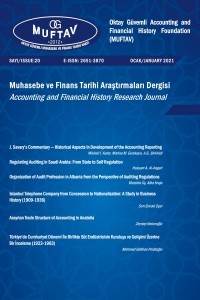XVI. ve XVII. Yüzyıllarda Osmanlı'da Tereke Uygulaması ve Muhasebesi - Sosyo-Ekonomik Yapıya Etkileri*
Osmanlı’da miras hukukunda tereke kurumu, devletin kuruluşundan itibaren altı yüz yıl boyunca uygulanmıştır. Bu uygulama, kadı (yargıç) nın başkanlığında katip (muhasebeci), kassam ( varlıkları bölüştüren kişi) ve dellaliye (borçlu ve alacaklı kişilerin belirlenmesi için duyuruları yapan kişi) den oluşan bir ekip tarafından yapılmaktadır. Varislerden birinin talebi üzerine düzenlenen terekede önce konu ile ilgili bilgi verilmekte; sonra varlıklar, giysiler, ev eşyaları, taşınmazlar, alacaklar ve nakit şeklinde envanter kurallarına ( malın türü, miktarı, değeri) uygun olarak düzenlenerek sıralanmaktadır. Üçüncü bölümde ise bu varlıkların bölüşümü üzerinde durulmaktadır. Önce borçlara ayrılan pay belirlenmekte, sonra tereke işlemlerinde görev alanların ücretlerine yer verilmekte, sonra da mirasçıların payları sıralanmaktadır. Mirasçı yoksa ya da tek ise, devletin pay sahipliği söz konusu olmaktadır. Eş, çocuklar ve öteki varisler, mirası belirli kurallara göre bölüşmektedirler. Muhasebeci, envanterin yapılması, alacakların ve borçların belirlenmesi, pay sahiplerinin paylarının hesaplanması ve nihayet tereke defterine gerekli kayıtların yapılmasında olduğu gibi tereke işlemlerinin hemen hemen tüm aşamalarında görev almaktadır. Osmanlı muhasebecileri, tereke defterlerindeki kayıtlarda, Osmanlı’da devlet muhasebesinde yüzyıllar boyu kullanılan merdiven yönteminden yararlanmışlardır. Tereke işlemlerinde muhasebecinin, hem tereke işlemlerinde ve hem de kayıtlarındaki bu hâkimiyetinin, kayıtların bir tasfiye bilançosu şeklinde hazırlanmasına imkan verdiği dikkati çekmektedir. Bu araştırmada XVI. ve XVII. yüzyıllara ait iki örnek ele alınarak inceleme konusu yapılmış olup, bu örneklerdeki bilgilerden tereke işlemlerinin belirli standartlar çerçevesinde geliştirilerek yüzyıllar boyu ayni esaslar çerçevesinde uygulandığı anlaşılmaktadır. Belirli standartlar çerçevesinde bu uzun süreli uygulamayı mümkün kılan iki hususun bulunduğunu belirtmek gerekmektedir. Bunlardan ilki miras hukukunun belirli kurallar çerçevesinde istikrarlı bir şekilde uzun süre uygulanmasıdır. İkincisi de Osmanlı’nın deneyimli muhasebecilerinin belirli standartlara bağlı olarak başarılı uygulamalarıdır. Terekede muhasebenin başarılı uygulamalarının, Osmanlı’nın sosyoekonomik yapısının korunmasında ve miras hukukunun yüzyıllar boyu ayni kurallar ile sürdürülmesinde büyük payı olduğu sonucuna varılmaktadır.
Anahtar Kelimeler:
Tereke, tereke muhasebesi, tasfiye bilançosu.
The Ottoman Estate (Inheritance) Application and Accounting in the 16th and 17th Centuries - Effects on Socio-Economic Structure and Inheritance Law
In Ottoman inheritance law, the estate application was implemented for six hundred years, since the establishment of the state. This implementation was carried out by a team composed of the Secretary (accountant), al-Quassam (the person who distributes assets) and announcer (the person who makes the announcements to determine the debtors and claimers) and chaired by Qadi (judge). In the Estate (inheritance) held at the request of one of the heritors, the relevant information is given initially, then the estates, clothing, household goods, real estates, receivables, and cash are arranged under rules (type, quantity and value of the assets) appropriately. The third section focuses on the distribution of these assets. First, the share of debts is determined, then the fees of those who participated in the estate transactions are included, and then the shares of the heritors are listed. If there aren’t any or there is just one heritor, the state owns the share. Spouses, children and other heritors share the inheritance according to certain rules. Accountants are involved in almost all stages of the estate transactions such as taking inventory, determining receivables and payables, calculating shares of shareholders, and finally recording in the estate book. In the records of the estate book, Ottoman accountants used the staircase (Merdiban) method, which was used for state accounting purposes in the Ottoman Empire for centuries. It should be noted that the dominance of the accountant in both estate transactions and recording allows the preparation of the records in the form of a liquidation balance sheet. In this paper, two cases from the 16th and 17th centuries are studied, and it is understood from these cases that estate transactions were developed within the framework of specific standards and were applied for centuries on the basis of the same principles. It should be indicated that there are two points that enable the application of these long-term transactions on the basis of standard rules. The first is the implementation of the inheritance law for a long time in a stable manner within the framework of certain rules. The second is the Ottoman’s experienced accountants successful applications conforming to specific standards. It is concluded that the successful application of estate accounting has had a large effect on the protection of the socio-economic structure of the Ottoman Empire and maintenance of inheritance law with the same rules for centuries.
- ISSN: 2146-4928
- Yayın Aralığı: Yılda 2 Sayı
- Başlangıç: 2011
- Yayıncı: Oktay Güvemli Muhasebe ve Finans Tarihi Vakfı (MUFTAV)
